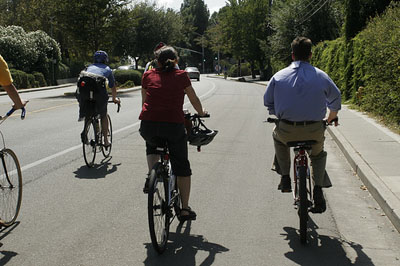Davis, CA has more registered bicycles than cars!
Only 15 miles
west ofCalifornia’s capital city, the city of
Davis is home to
about 61,000 people and more than 60,000 registered bicycles. Recognized
as a Platinum Level Bicycle Friendly Community by the League of American
Bicyclists, Davis has transformed its people and urban
landscape to accommodate this easy, cost-efficient, healthy mode of
transportation.
Davis did not institute citywide bicycle
planning in response to today’s high gas prices. In fact, the issue of
Davis
’
insufficient transportation infrastructure was identified as early as the
mid-1960s. In fact, in 1966, when bikeways became a major issue in the
City Council elections, several pro-bike candidates won; and the system has been
steadily expanding ever since. In the spirit of preventing, not responding
to, a transportation crisis, the city of
Davis
has invested about $14 million on bike projects in the past 10 years.
One of the
University of
California’s 10 campuses is located in
Davis
, and of the
approximately 30,000 students enrolled at UC Davis, it is estimated 48 percent
of them ride a bike or walk to class. The city and university’s partnership has
strengthened the bicycle program, creating more than 50 miles of on-street bike
lanes and 52 miles of off-street bike paths – all within an area of less than 10
square miles.

Bicycle Lane in
Davis
- Photo Courtesy of
Kate Michelle McCarthy
While bicycle use is an important
part of the city’s transportation network,
Davis
also connects its bicyclists to Unitrans
– a public transit system owned and operated by the students of UC Davis. More
than 3 million trips per year – at the cost of $1 per trip – are taken in the
city along 14 separate routes on picturesque, double-decker buses purchased from
London
. These buses easily connect with bicycle
park n’ ride stations throughout the city, as well as other key locations where
bicycles can be rented.
In this region, cities like
Evanston, Elgin,
Homewood and Naperville for their commitments to building
bicycle capacity in their communities. A lack of capital dollars limits the
extent of transit investments in many places throughout our region and bicycle
investments are now being more widely accepted as a part of a well balanced
integrated transportation network.
This article was featured in Talking
Transit, MPC’s bi-weekly e-newsletter. To receive the newsletter, email talkingtransit@metroplanning.org
with ‘Subscribe’ in the subject line.